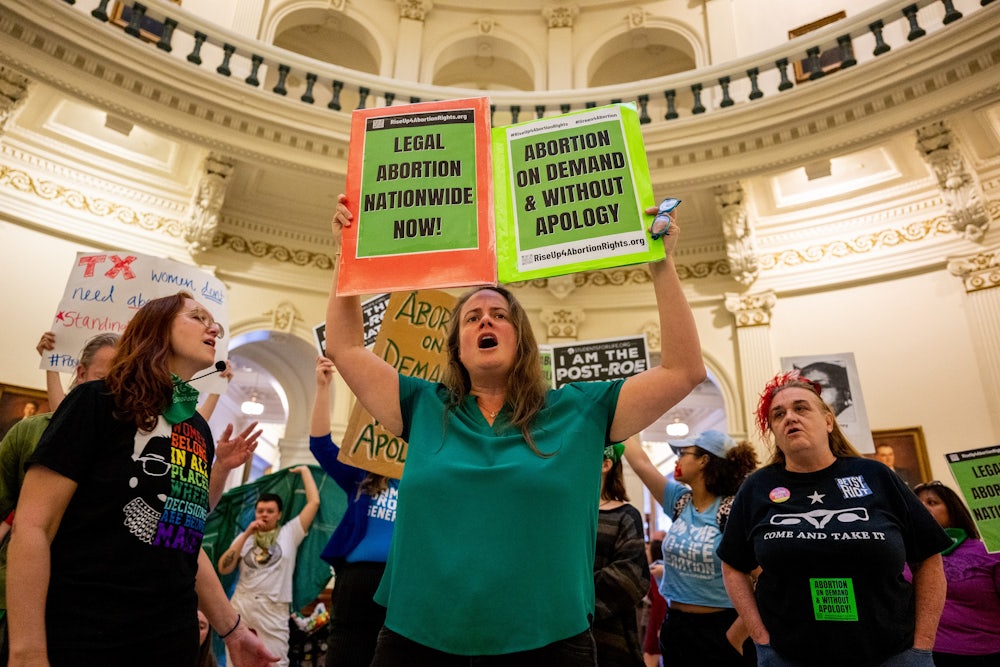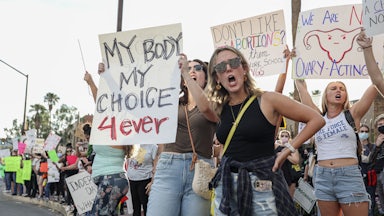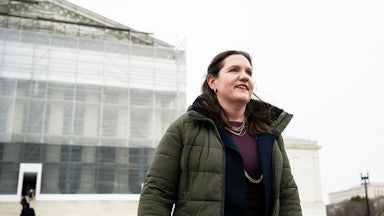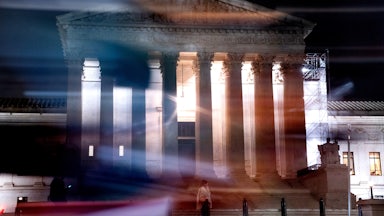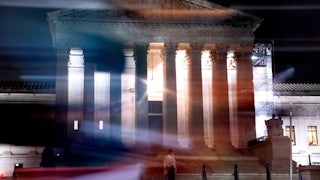Abortion rights played a major role in last year’s midterm elections, blunting GOP momentum in some key congressional races and helping Democrats hold governorships and state legislatures in battleground states like Michigan, Pennsylvania, and Wisconsin. That trend shows no sign of abating in 2023. In Wisconsin, where control of the state Supreme Court is up for grabs this year, the liberal and conservative candidates are defining themselves almost entirely based on the issue.
Janet Protasiewicz, a Milwaukee County circuit judge, has released TV ads in which she describes herself as a “commonsense judge” who “believe[s] in a woman’s freedom to make her own decision on abortion.” Dan Kelly, who previously served as a state Supreme Court justice from 2016 to 2020, has done legal work for state anti-abortion groups and has been endorsed by them in the upcoming April 4 election. While neither judge has said definitively how they would rule on an expected challenge to the state’s 1849 law banning the procedure, there is also little doubt about which way they may be leaning.
The Wisconsin race highlights how state supreme courts will help define the new frontier for abortion rights in a post-Roe America. The Supreme Court’s decision in Dobbs v. Jackson Women’s Health Organization last summer declared that there was no federal constitutional right to obtain the procedure, ending nearly a half-century of nationwide protection for abortion access. State supreme courts—and the state constitutions they interpret—may yet protect that right when others will not.
One such ruling came on Thursday from the North Dakota Supreme Court. In Wrigley v. Romanick, the state sought to overturn a local judge’s injunction that barred officials from enforcing an abortion ban that would criminalize the procedure in all circumstances but allowed doctors to claim that the mother’s life was at risk or that it was a rape or incest case as an affirmative defense if they are prosecuted.
Red River Women’s Clinic, the only abortion provider in the state prior to the law’s enactment, challenged the law by arguing that it violated a state constitutional right to obtain the procedure. The state Supreme Court agreed, but on narrow grounds. “The North Dakota Constitution explicitly provides all citizens of North Dakota the right of enjoying and defending life and pursuing and obtaining safety,” Chief Justice Jon Jensen wrote for the court. “These rights implicitly include the right to obtain an abortion to preserve the woman’s life or health.”
Jensen noted that while the state had criminalized abortion since the nineteenth century, it had also consistently included an exception for the mother’s life or health. That makes the ruling much narrower than the federal constitutional status quo prior to Dobbs. At the same time, it was enough to block the statute for being insufficiently “narrowly tailored” to avoid violating the state constitutional right. Jensen noted, for example, that the statute’s language would appear to exclude ectopic pregnancies and thus put physicians in legal jeopardy for treating them.
In a concurring opinion, Justice Jerod Tufte added that such a reading would logically fit with the state constitution’s protections for the common-law right to self-defense. “Where a pregnancy raises a similar threat of serious bodily injury or death, the pregnant woman has a fundamental right to preserve her life and health with the aid of a physician,” he explained. “Our recognition of this fundamental right to preserve one’s life does not depend on resolving the disputed point of pregnancy at which there are two lives that must be considered.” While possible links between the right to self-defense and abortion access have been debated in legal scholarship, this appears to be the first reference to them by a court.
Other states have seen similar post-Dobbs court cases since last summer. The Kentucky Supreme Court ruled in February that two laws imposing a near-total ban on abortion access could be enforced while legal challenges against them are heard. The groups challenging the laws argued that they violate language in the Kentucky state constitution that promises the “right of seeking and pursuing their safety and happiness” to the state’s residents. Last November, Kentucky voters had defeated a constitutional amendment that would have explicitly declared that there was no right to obtain an abortion in the state constitution.
Every state in the Union has its own constitution, and many of them include a list of protected rights similar to the Bill of Rights for the federal Constitution. While some of these rights simply reflect those protected at the national level, some state constitutions go even further than their federal counterpart to protect certain rights. If the federal Constitution is the proverbial floor for Americans’ rights, then state constitutions can define the ceiling.
Take, for instance, the difference between the Fourth Amendment of the federal Constitution and a similar (but not identical) provision in the South Carolina state constitution. The Fourth Amendment holds that “the right of the people to be secure in their persons, houses, papers, and effects, against unreasonable searches and seizures, shall not be violated.” In South Carolina’s constitution, however, the related provision says that “the right of the people to be secure in their persons, houses, papers, and effects against unreasonable searches and seizures and unreasonable invasions of privacy shall not be violated.” (Emphasis mine.)
In January, the South Carolina Supreme Court struck down a six-week ban on abortion in the state by grounding a state-level right to obtain the procedure in the provision. The court noted that it had previously applied the “unreasonable invasions of privacy” language to medical-privacy cases beyond the typical search-and-seizure context and that a woman’s right to obtain an abortion naturally fell within that right’s purview. “We are persuaded by the logic replete in the opinions we have surveyed that few decisions in life are more private than the decision whether to terminate a pregnancy,” Justice Kaye Hearn wrote for the court. “Our privacy right must be implicated by restrictions on that decision.”
State supreme courts generally have the final say when interpreting their own state constitution as long as it does not violate the federal one. That means a state supreme court’s interpretation of a state constitutional right to abortion cannot, in theory, be overturned by the U.S. Supreme Court. The Center for Reproductive Rights identified 10 states in a report last July where state supreme courts already provide greater protections for abortion rights that were independent of any federal court rulings.
This might not necessarily stop anti-abortion state lawmakers from pursuing and passing anti-abortion legislation, just as a pro-Roe majority on the Supreme Court did not stop dozens of state legislatures from passing laws to restrict or ban the procedure in the years leading up to Roe’s overturning in Dobbs. But it could provide a judicial backstop against some of the more extreme forms of legislation under consideration. South Carolina lawmakers, for example, are reportedly considering a bill that would reclassify abortion under the state’s homicide laws, making women who obtain one theoretically eligible for the death penalty.
The renewed focus on state supreme courts is especially important since voters elect, to varying degrees, members of their state supreme courts in most states. According to the Brennan Center for Justice, at least 38 states either directly elect their state supreme court justices or hold retention elections for justices who are initially appointed by a governor. That makes them potentially more reflective of public sentiment than the U.S. Supreme Court, whose members serve for lifetime terms. To that end, state supreme court races drew even greater attention in last year’s midterms because of the potential ramifications for abortion rights.
Not every state supreme court will have the same latitude to rule in favor of abortion rights or against them. State supreme courts also hear a variety of cases, of course, and some voters may be just as motivated by concerns about election denial or other issues. But the amount of money pouring into this year’s Wisconsin race—at least $27 million from outside groups, by one count—and the focus on abortion rights as a central divide between the two candidates suggests that it will be a potent force in races where it can make a difference. Last year, the country’s high-stakes abortion cases flowed through just one court. That number will only grow in a post-Dobbs world.
